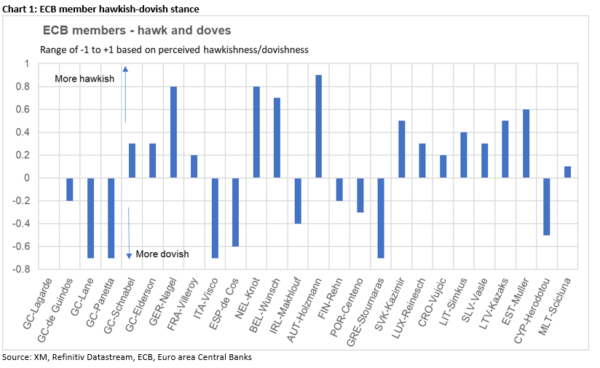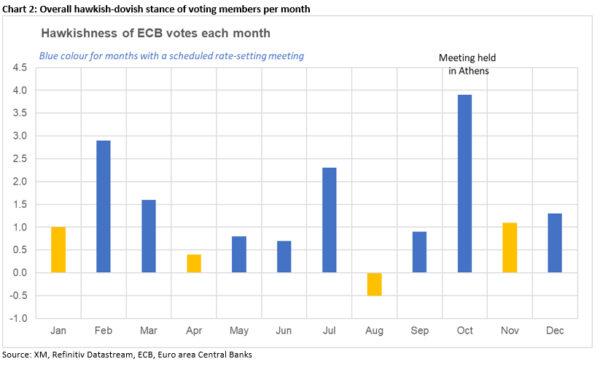The ECB prepares to hold its first rate-setting meeting for 2023 on February 2. The market is almost certain that another 50 bps rate hike will be announced next week. The attention falls on the ECB outlook as an open debate among the ECB members is developing before our eyes. Both sides have sound arguments with the doves regaining strength following the recent easing in both the inflation rates and commodity prices. But who has the upper hand at the February meeting?
Voting rotation in place
Similar to the Fed, the ECB has adopted a voting rotation since January 1, 2015 as the euro area countries exceeded a predefined number of 18. Contrary to the Fed where specific members are voting for the entire calendar year, the ECB is enforcing a monthly voting rotation.
In more detail, the six members of the governing council vote every month, a situation similar to the Fed’s voting system. The 20 eurozone countries are then split in to two groups. The first group consisting of Germany, France, Italy, Spain and the Netherlands share four votes every month. In practice, one representative of the aforementioned countries will not vote each month. The remaining 15 countries share just 11 votes. In total, there are only 21 votes to be cast each month if there is a policy meeting scheduled. Naturally, all ECB members take part in the discussions and deliberations at the meetings.
The usual hawks-doves division
The ECB members have been traditionally separated to hawks and doves based on their opinions on both monetary policy and the overall eurozone economic outlook. The group of hawks advocates for a more aggressive stance, it is historically led by the Bundesbank governor and it encompasses most governors of the northern eurozone countries. On the other hand, doves are the ECB members that tend to support a looser approach, especially at this juncture that the Fed prepares to press the brakes on further rate hikes. Traditionally, the governors coming from the European South belong to this dovish camp. Chart 1 below shows our estimation of the hawkishness and dovishness of the 26 ECB members based on their recent commentary.
Hawkishness per month
Based on the perceived hawkishness of the ECB members, we have gone a step further and calculated the relative hawkishness/dovishness of the voting members for each month – presented at Chart 2 below. We have colour-coded the eight rate-setting meeting set for 2023. Interestingly, the most hawkish voting stance comes at the October meeting that is scheduled to be held in Athens, Greece. Traditionally, the ECB tends to avoid making significant announcements away from Frankfurt, unless there is a crisis in the market.
What does this mean for the February 2 meeting?
The February meeting records the second highest hawkish voting stance in 2023. This potentially means that an attempt by the ECB doves to gain the upper hand at the meeting and disproportionately influence the decision-making process could be blocked by the hawks. Based on recent comments by notable hawks, they do not appear to have shifted their stance regarding the next rate hikes despite the recent improved economic data releases. This could also mean that any dovish market expectations going into the meeting could potentially face a difficult time. Despite the recent market sentiment favouring the euro, the overall positioning in the market appears to be more dollar positive. On face value, this situation increases the chances for a more sizeable move next week if the ECB manages to present a more hawkish stance than anticipated, and hence disappoint the euro doves. Similarly, the recent dip in yields could be reversed after the meeting, especially if on February 1 chairman Powell fails to meet the dovish Fed expectations. To sum up, the market focus next week will almost entirely fall on the overall language of the ECB statement and the usual press conference by president Lagarde.














